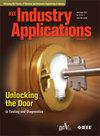Data-Driven Modeling of Li-Ion Battery Based on the Manufacturer Specifications and Laboratory Measurements
IF 4.2
2区 工程技术
Q2 ENGINEERING, ELECTRICAL & ELECTRONIC
引用次数: 0
Abstract
Accurate modeling of Lithium-ion battery is essential in the development and testing of state estimation and lifetime prediction algorithms. The desired features of the model include flexibility, fast development, accuracy and reliability. There are many different ways to model a battery, depending on the level of abstraction desired, the data available and the target application environment. This paper shows how to extract equivalent circuit model parameters from manufacturer datasheets and laboratory measurement to build robust battery simulation models. A step-by-step methodology for data preparation is presented for both datasheet and measurement-based methods. The benefits and the disadvantages of both approaches are also discussed. A simple equivalent circuit model is firstly derived from manufacturer specification and its robustness is enhanced by collecting more extensive experimental data in the laboratory. Furthermore, an advanced model to better capture the battery dynamics is developed. The aging effects are added to this battery model, to reflect the internal parameters variation according to the health condition of the battery. To measure the accuracy of the developed models, the relative error is computed. An initial relative error of 2.8% of the model build with manufacturer specifications is reduced to 1.0% using laboratory measurements and finally to less than 0.4% by incorporating aging effects.基于制造商规格和实验室测量的锂离子电池数据驱动建模
锂离子电池的精确建模在状态估计和寿命预测算法的开发和测试中至关重要。该模型的期望特性包括灵活性、快速开发、准确性和可靠性。有许多不同的方法可以对电池进行建模,这取决于所需的抽象级别、可用的数据和目标应用程序环境。本文介绍了如何从制造商数据表和实验室测量中提取等效电路模型参数,以建立稳健的电池仿真模型。为数据表和基于测量的方法提出了数据准备的一步一步的方法。本文还讨论了这两种方法的优缺点。首先根据制造商的说明书推导出简单的等效电路模型,并通过在实验室中收集更广泛的实验数据来增强其鲁棒性。在此基础上,建立了更好地捕捉电池动态特性的先进模型。在该电池模型中加入老化效应,以反映电池内部参数随电池健康状况的变化。为了测量所建立模型的精度,计算了相对误差。根据制造商规格建立的模型的初始相对误差为2.8%,通过实验室测量减少到1.0%,通过考虑老化效应最终减少到0.4%以下。
本文章由计算机程序翻译,如有差异,请以英文原文为准。
求助全文
约1分钟内获得全文
求助全文
来源期刊

IEEE Transactions on Industry Applications
工程技术-工程:电子与电气
CiteScore
9.90
自引率
9.10%
发文量
747
审稿时长
3.3 months
期刊介绍:
The scope of the IEEE Transactions on Industry Applications includes all scope items of the IEEE Industry Applications Society, that is, the advancement of the theory and practice of electrical and electronic engineering in the development, design, manufacture, and application of electrical systems, apparatus, devices, and controls to the processes and equipment of industry and commerce; the promotion of safe, reliable, and economic installations; industry leadership in energy conservation and environmental, health, and safety issues; the creation of voluntary engineering standards and recommended practices; and the professional development of its membership.
 求助内容:
求助内容: 应助结果提醒方式:
应助结果提醒方式:


